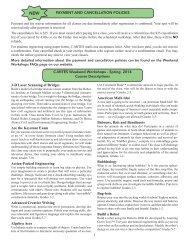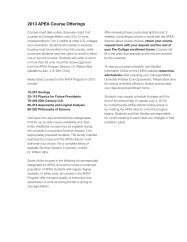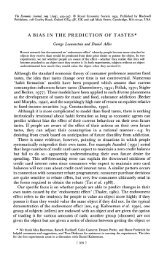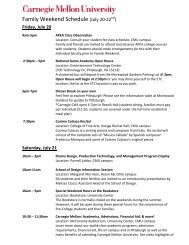Pittsburgh International Airport Area Development Vision Plan ...
Pittsburgh International Airport Area Development Vision Plan ...
Pittsburgh International Airport Area Development Vision Plan ...
Create successful ePaper yourself
Turn your PDF publications into a flip-book with our unique Google optimized e-Paper software.
Opportunities & Challenges<br />
Opportunities<br />
› Creates an international magnet to draw passengers to the airport<br />
One of the important synergies this model offers is the development of a large-scale development anchored<br />
around the Energy Center that is global in its scope and influence, attracting technical experts, leaders, and<br />
workers from all parts of the world. Not only would the airport serve the new development, but the new town<br />
would increase the demand for flights and other airport services.<br />
› Offers easy access to the airport<br />
The Findlay Connector offers fast and direct access to the airport. It offers capacity beyond its utilization in the<br />
foreseeable future, and if the Southern Beltway is built, it will be a key stop between the airport, major regional<br />
destinations, and the interstate highway system.<br />
› Redevelops brownfield sites<br />
One of the benefits of the Beech Hollow site is that it is not only ideally located in terms of future airport-related<br />
development, but it transforms an environmental liability into a major regional asset. Because the brownfield<br />
has already been regraded and filled, it offers a large and relatively flat buildable area, which is hard to<br />
find in the region.<br />
› Limits infrastructure costs for new development by concentrating it<br />
The new town achieves high-value development opportunities at a much lower infrastructure cost than the<br />
alternative of single-use suburban development. <strong>Plan</strong>ned sites for multi-use development provide a mutually<br />
supportive context--eg, workplaces within walking distance of dining/entertainment and housing.<br />
› Enhances open space system<br />
The New Town Model focuses development on land that has been compromised by prior use, leaving prime<br />
land available for amenities, which are assets not only to the new town but to the existing communities in the<br />
region.<br />
› Offers high quality of life: small community in natural setting<br />
Aside from the economic benefits of bringing greater airport-related development to the region, the New<br />
Town Model creates a “new town” environment that has been shown to be one of the most successful models<br />
of growth in the last several decades.<br />
› Provides a distinctive sense of place<br />
More than any of the other three models, the New Town Model creates an identifiable place that demonstrates<br />
the positive impact of the airport as a regional amenity and can become a major asset in promoting the<br />
region.<br />
58 <strong>Pittsburgh</strong> <strong>International</strong> <strong>Airport</strong> <strong>Area</strong> <strong>Development</strong> <strong>Vision</strong> <strong>Plan</strong> (Aerotropolis) September 2011 September 2011 <strong>Pittsburgh</strong> <strong>International</strong> <strong>Airport</strong> <strong>Area</strong> <strong>Development</strong> <strong>Vision</strong> <strong>Plan</strong> (Aerotropolis) 59<br />
Challenges<br />
› Land assembly and remediation<br />
A planned new town development requires the acquisition of 600 to 1000 acres. Fortunately, the Beech Hollow<br />
property is in large landholdings that will facilitate assembly. However, the financial and political effort to<br />
obtain site control of such a large area requires dedication and time.<br />
› Timing and phasing<br />
New town development is larger in scale than property--by-property development, which means that it brings<br />
greater risks, financial and otherwise. The phasing strategy must create marketable sites that are “complete”<br />
in themselves but initially not burdened by excessive costs of infrastructure or amenities. Successful timing<br />
involves strategies to “land” major anchor uses at the critical points in the process.<br />
› Cooperative agreements between townships and counties<br />
As mentioned earlier, this model requires a greater level of inter-jurisdictional cooperation and planning than<br />
has been achieved to date. As explained in the ULI’s airport development study, this will have many benefits<br />
beyond the new town itself.<br />
› Design guidelines needed for good quality development and public spaces<br />
Successful new communities need to establish an attractive physical identity and a coherence that can be created<br />
only with agreements concerning the form and location of buildings, streets, and common spaces. Since<br />
planning will need to go beyond the level of land use plans that have been the norm in the region, there will be<br />
an even greater emphasis on cooperation at the local, county, and regional levels.







![Pittsburgh Neighborhoods [.pdf] - Carnegie Mellon University](https://img.yumpu.com/22011290/1/190x115/pittsburgh-neighborhoods-pdf-carnegie-mellon-university.jpg?quality=85)
![Curriculum Vitae [.pdf] - Carnegie Mellon University](https://img.yumpu.com/20737100/1/190x245/curriculum-vitae-pdf-carnegie-mellon-university.jpg?quality=85)







![May 2012 [.pdf] - Carnegie Mellon University](https://img.yumpu.com/12198417/1/190x253/may-2012-pdf-carnegie-mellon-university.jpg?quality=85)
